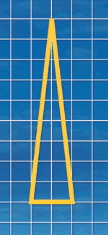Isosceles triangles
Draw some isosceles triangles with an area of $9$cm$^2$ and a vertex at (20,20). If all the vertices must have whole number coordinates, how many is it possible to draw?
Problem
Isosceles Triangles printable sheet

This question is about isosceles triangles with an area of 9 cm$^2$.
One of the vertices must be at the point (20, 20).
Each vertex of the triangle must be at a grid point of a square grid, so all the vertices will have whole number coordinates.
How many different triangles satisfy these four conditions?
Try to find them all. You may wish to use the GeoGebra applet below.
Can you explain how you know that you have found them all?
Click here for a poster of this problem.
Getting Started
Isosceles triangles have two equal sides.
The area of a triangle is half the base times the height.
Any of the three vertices of the triangle can be at $(20, 20)$.
There are sets of identical (congruent) triangles with an area of $9$cm$^2$.
How many triangles are there in each set? How many sets?
Student Solutions
Uday from Pate's Grammar School in the UK explained how to find all of the possible whole number side lengths:
We know that, (base $\times$ height) ÷ 2 is the area of a triangle so we know that the height $\times$ base should equal 18. From there, we know that the factors of 18 are 1, 18, 2, 9, 3 and 6. Now we know the height and base measurements of the triangles. We use that to find the triangles.
Yash from Tanglin Trust School in Singapore checked that these can be used to form all of the possible isosceles triangles with integer coordinates:
Since isosceles triangles have two equal sides, it must have a base of a length divisible by 2 in order to have integer coordinates.
Ci Hui Minh Ngoc Ong from Kelvin Grove State College (Brisbane) in Australia found all of the different ways these triangles could be positioned on the coordinate grid. Ci Hui Minh Ngoc Ong concluded that each triangle can be positioned in 12 different ways, so a total of 36 isosceles triangles with area 9 and a vertex at (20,20) can be drawn on a coordinate grid.
Click here to see Ci Hui Minh Ngoc Ong's work.
Teachers' Resources
Why do this problem?
Paul Andrews, a respected mathematics educator based at Cambridge University, explains why he likes this problem :
I love it because it forces an acknowledgement of so many different topics in mathematics and is sufficiently challenging to keep almost any group meaningfully occupied within a framework of Key Stage Three mathematics content. This, for me, is the key to a good problem; Key Stage Three content alongside non-standard and unexpected outcomes.
For example, notwithstanding the obvious problem solving skills necessary for managing such a non-standard problem, I think it requires an understanding of coordinates, isosceles triangles and the area of a triangle. It requires an awareness of the different factors of 18 and which are likely to yield productive solutions. It requires, also, an understanding not only of basic transformations like reflection and rotation but also an awareness of their symmetries. Moreover, the solution, which is numerically quite small, is attainable without being trivial.
In short, I love this problem because of the wealth of basic ideas it encapsulates and the sheer joy it brings to problem solvers, of whatever age, when they see why the answer has to be as it is. It is truly the best problem ever and can provoke some interesting extensions."
Possible approach
This printable worksheet may be useful: Isosceles Triangles.
Show the class this triangle and ask them to list as many properties of the triangle as they can.

Group students into threes or fours.
Ask them to find some triangles that satisfy the following criteria:
- It is an isosceles triangle.
- The area is 9 square centimetres.
- Each vertex has whole number coordinates.
- One of the vertices is at (20, 20).
Once students have found a few examples, you may wish to use the interactive applet in the problem to check their work. Then challenge them to find all the possible triangles that satisfy the four conditions.
Make it clear that you will expect them to justify that they have found all possibilities.
Once groups feel that they have finished, they could try to explain clearly to the class why they are convinced they have found all of the solutions. Those who missed out solutions could be encouraged to think about why these solutions were overlooked.
Key questions
- How do you know that your triangles have the correct area?
- Are there any more like that?
- Can you explain why you are certain that there are no more solutions?
Possible support
Possible extension
Challenge students to find a general method for working out how many different isosceles triangles can be drawn for any given area (assuming we retain all the other constraints).
